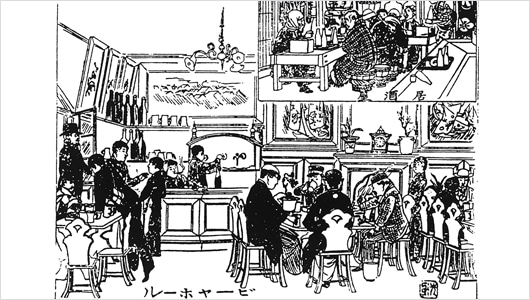Japan’s first beer hall


In August 1899, the Yebisu Beer Hall opened in what is modern day Ginza 8-chome, Tokyo. This was Japan’s first beer hall. Makoshi’s idea for a beer hall was originally intended as a way of promoting the beer brand. The goal was to have prospective customers try draft beer shipped straight from the brewery and experience its quality for themselves. To name the establishment, they turned to both Japanese and foreign nationals with knowledge of English. A missionary suggested the idea of calling it a “beer salon.” The motion was approved, albeit for a short time. They changed course when a British man noted that the missionary had envisioned a refined salon, but that the same term connoted a den of ill repute in the Yokohama area. This would not do, so they shifted to calling it a “beer hall.”
The beer-exclusive pub was a smash hit


The Yebisu Beer Hall was just 132 square meters in size, but the interior was done up with a counter to the left of the entrance and stands featuring nickel. The floors featured linoleum, which was a cutting-edge material at the time. The man responsible for the interior design was Yorinaka Tsumaki, a leader of modern architecture in the Meiji period. Beer was 10 sen (1 sen being 1/100th of a yen) and served in glass steins. It was a rousing success: 225 liters were served on the first day, then 245 on the second day, and 450 on the third day. Customers heard news of the establishment and traveled far and wide to try it. Edoites, who had a penchant for all things new, loved it. Within a week of opening, they even had days where they briskly sold 1,000 liters of beer. Though intended as a form of PR, the shop was posting solid revenue and became a source of income in its own right. However, there was one thing customers were dissatisfied with. The only side dishes first offered were sliced Japanese daikon radishes, served in the Western style. The idea was to eat them like radishes found in a German pub, but the dish simply failed to catch on. They then experimented with butterburr and shrimp preserved in soy, which fared much better.